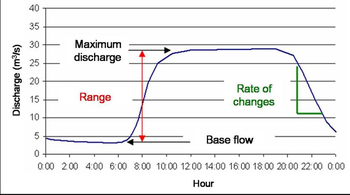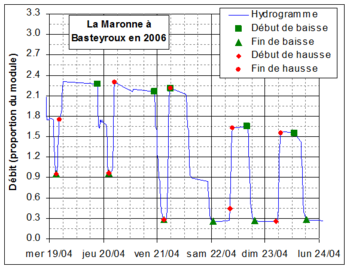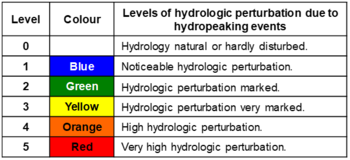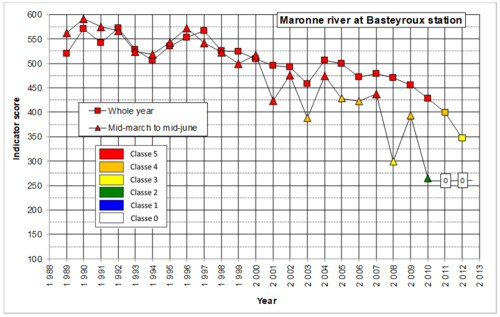Difference between revisions of "Hydropeaking indicator"
Bendikhansen (talk | contribs) m (Text replacement - "=Mitigation measures where MTD might be applied=" to "=Relevant mitigation measures and test cases=") |
Bendikhansen (talk | contribs) |
||
| Line 28: | Line 28: | ||
=Relevant mitigation measures and test cases= | =Relevant mitigation measures and test cases= | ||
{{Suitable measures for Hydropeaking indicator}} | {{Suitable measures for Hydropeaking indicator}} | ||
| − | |||
=Other information= | =Other information= | ||
Revision as of 11:01, 29 January 2020
Contents
Quick summary
Developed by: French Agency For Biodiversity, Ecohydraulic Team AFB-IMFT, Courret D, Larinier M and Baran P.
Date: 2014
Type: Tool
Introduction
Hydropeaking at hydroelectric facilities (more than 150 in France) generates sudden changes in flow in the river and can affect the composition, the abundance and the structure of fish and invertebrates populations over long distances. The objectives of the “Hydropeaking indicator” tool are (1) to characterize peaks within hydrograph and (2) to produce a synthetic indicator of hydrological disturbance, related to the impacts on fish populations.
From the analysis of 97 stations and 1575 years of flow data, rates of change of natural flow variations have been first characterized (Figure 1 and 2) within 8 ranges between 5% and 4 times the mean inter-annual discharge. Formulas representing the "fastest variations possible naturally" and taking into account the type of change (increase or decrease), the size of the stream (via the mean inter-annual discharge) and the flow range over which the variation takes place have been constructed and then used to discriminate hydropeaks and natural events.
From the analysis of 80 stations and 491 years of flow data affected by hydropeaking, a method was developed to identify, within the hydrograph, hydropeaks whose characteristics are beyond what can occur in natural hydrology, using 3 criteria: a minimum range (≥ 10% of the mean inter-annual discharge and ≥ 20% of the hydropeak base flow), a minimal rate of change (> to the maximum natural rate of change) and an upper limit on the maximum flow rate (to remove flood events).
A synthetic indicator differentiating 5 levels of hydrological disturbance induced by hydropeaking regimes was constructed (Figure 3). The level of disturbance of each of the 491 years of flow data was evaluated by 3 expert operators according to the knowledge of the biological impacts of hydropeaking. The linear discriminant analysis allows reproducing this classification using 5 characteristic parameters of hydropeaking regimes (87% of correct reclassification).
Application
The hydropeaking Indicator needs discharge time series as input file, with a fixed or variable time step. This time step should be short to precisely describe the hydropeaks (< 0.5-1 h). The indicator can be produced per year or per period corresponding to biological phases / seasons. Its automated calculation requires knowing only the mean inter-annual flow of the river and the maximum turbine discharge of the hydropower plant upstream.
The hydropeaking Indicator produces (1) a set of parameters that characterizes each hydropeak (base flow, maximum flow, rate of change…) and their statistics, and (2) the score provided by the discriminant analysis and the level of perturbation.
Examples show that the indicator is sensitive to changes in hydropower plant management and allows appreciating the spatial and temporal changes in hydropeaking regimes, including the damping in the downstream direction (Figure 4). This indicator is a tool for managers of "pre-diagnosis" of biological impacts and for monitoring spatial and temporal changes in hydropeaking.
Relevant mitigation measures and test cases
| Relevant measures | |
|---|---|
| Fish refuge under hydropeaking conditions | |
| Mitigating rapid, short-term variations in flow (hydro-peaking operations) | |
| Mitigating reduced annual flow and low flow measures | |
| Mitigating reduced flood peaks, magnitudes, and frequency | |
| Relevant test cases | Applied in test case? |
| Anundsjö test case | - |
| Bragado test case | Yes |
Other information
The Hydropeaking Indicator is implemented in an Excel sheet, using a macro coded in Visual Basic. The tool can be transmitted for free by the Ecohydraulic Team AFB-IMFT after agreement.
At the French Test Cases an electromagnetic flow meter Marsh McBirney, FLO-MATE 2000 is used.
Relevant literature
- Courret D, 2010. Etude des gradients des variations de débit naturelles en vue de la fixation des critères pour le repérage des éclusées hydroélectriques. Rapport GHAAPPE RA.09.04.
- http://oai.eau-adour-garonne.fr/oai-documents/59478/GED_00000000.pdf
- Courret D, Larinier M, Baran P, 2014. Développement d’une méthodologie de caractérisation des éclusées hydroélectriques et Définition d’un indicateur du niveau de la perturbation hydrologique *induite (seconde version). Rapport GHAAPPE RA.14.02.
- Courret D., 2014. Caractérisation de la perturbation hydrologique induite par les régimes d'éclusées hydroélectriques et définition d'un indicateur - Réflexion sur les mesures de mitigation des impacts des éclusées sur les populations de poissons. Thèse de l'INP Toulouse.
- http://ethesis.inp-toulouse.fr/archive/00002880/



